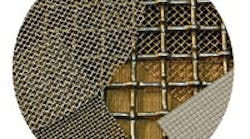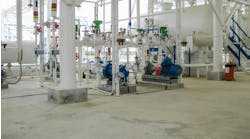Solids Separation: Tailor Your Wire Cloth
It is difficult to imagine a fluid handling system that doesn't employ wire cloth, mesh or screen in one capacity or another. Wire cloth long has been used for its ability to separate the desirable from the undesirable. It can filter particulates ranging in size from inches and above to a few microns and below. Moreover, the material provides strength, rigidity and consistent sizing performance, retains impurities or treatment material and, by virtue of its design, doesn't tend to impede flow.
For instance, its capability for separating liquid from solid has made wire cloth virtually indispensable in water pollution control — e.g., for screening raw water intake and removing particulate matter from plant effluent. Likewise, the material handles a variety of duties in air pollution control: meshes woven of silver, platinum or other precious metals are used in catalytic combustion processes while more-conventional wire cloths serve as baghouse filters and backing cloths for services requiring extra strength and corrosion resistance, and as arresters on stacks to prevent escape of sparks, cinders and other coarse particulates. Wire cloth screens also are finding increasing application as a contact medium for cooling towers to control thermal pollution. In addition, the material can act as a sound barrier to abate noise.
Figure 1. Pressure drop at higher flow rate can increase dramatically for more viscous fluids.
Process uses also abound. For instance, ion-exchange-resin and activated-carbon treatment systems for process water often rely on wire cloth for collectors, under-drains and distributors. The material also serves for centrifuge cloths and backing cloths of all kinds. In addition, it frequently is used to remove scale and construction debris to protect pumps and other equipment.CHOOSING THE CORRECT CLOTHProper selection of wire cloth can make a big difference in the cost and efficiency of a system. Making the right choice requires consideration of a variety of important factors. For instance, use in a liquid waste system involves coordinating pressure drop requirements with liquid temperature, viscosity and specific gravity as well as factoring in the size of particulate matter, flow rates and the nature of the contaminants or the corrosive environment to be encountered.Once the parameters are set, there almost certainly will be a suitable wire cloth for the job. Hundreds of standard cloths are available in the common metals, stainless steels, high-nickel alloys, titanium, etc. In most cases, the engineer won't need to custom design a cloth; manufacturers are helpful with application and metallurgical assistance for specific problems.Let's now look a bit more closely at some of the key parameters to assess.RETENTION SIZEYou first must determine the retention size, often given in microns, needed to separate the particulate matter (which either may be a waste or the desired product) from the influent stream. Vendors provide charts that relate micron size to wire diameter and mesh count per inch. So-called market-grade cloths are most common but many other weaves and engineered configurations also are available. When a particular retention is critical for the filtration process, select a value slightly smaller than that actually needed, to accommodate standard tolerances and ensure the correct result. Various wire mesh alternatives can attain equal retentions — but with different flow-rate/pressure-drop profiles. For example, a standard market-grade 40 mesh with wire diameter of 0.010 in. and an open area of 36.0%, and a "mill screen" 48 mesh with a wire diameter of 0.0055 in. and an open area of 54.2% both have a retention of 389 µ. The mill screen alternative offers a higher flow rate (or lower pressure drop) because of its greater open area but lacks the strength of its standard market-grade counterpart.Table 1. These are only rough guidelines because suitability also depends upon other factors such as concentration, temperature, environment, etc.
Table 2. Metals commonly used in high-temperature services vary significantly in their temperature limits.
E. MARVIN GREENSTEIN is director of engineering of Newark Wire Cloth, Clifton, N.J. E-mail him at [email protected].





